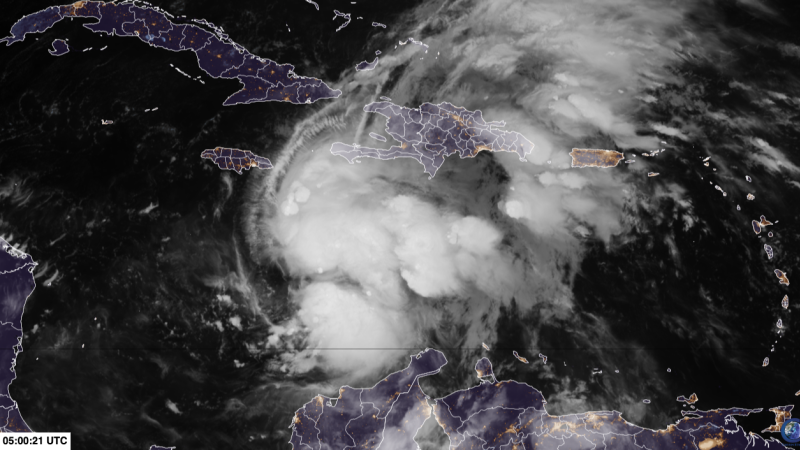Jamaica and other parts of the Caribbean are staring down what could become a catastrophic, days-long assault of extreme rainfall and damaging winds with Tropical Storm Melissa set to strengthen into a major hurricane over some of the hottest ocean water on the planet.
Officials are urging anyone in Melissa’s path to prepare for life-threatening flooding, landslides, power outages and dangerous seas.
Melissa’s rain has already been pounding parts of Haiti and the Dominican Republic for several days, flooding roadways and triggering landslides. At least three deaths have been reported in Haiti due to the storm, two of which were the result of a landslide, the Haitian Civil Protection Agency said in a statement.
Southern Haiti and nearby Jamaica are under both tropical storm warnings and hurricane watches with strong winds set to arrive as soon as Friday night and ramp up over the weekend.
As of Friday morning, Melissa is just over 150 miles south-southeast of Kingston, Jamaica, with sustained winds of 45 mph, according to the National Hurricane Center. The storm is hardly moving.
Melissa is expected to rapidly intensify into a Category 4 or stronger hurricane by Sunday, hovering near or south of Jamaica with punishing wind and torrential rain through early next week.
This explosive strengthening is happening more often as the world warms due to fossil fuel pollution. Three of the four Atlantic hurricanes this season underwent extreme rapid intensification: Erin, Gabrielle and Humberto.
Jamaica and Haiti are expected to feel the worst of Melissa’s wrath in the coming days, but surrounding countries cannot let their guards down.
A foot or more of rain is possible in parts of Jamaica, southern Haiti and the southern Dominican Republic through early next week.
“Extensive damage to roads and buildings is expected, potentially isolating communities for an extended period of time,” the hurricane center warned of Haiti on Friday. “This is a life-threatening situation and immediate preparations to protect life and property should be taken.”
Jamaica will not only endure Melissa’s torrential rain, but will also have to contend with days of the storm’s ferocious winds. The nation of nearly 3 million people will likely face tropical storm-force winds by Friday night, while hurricane-force winds build over the weekend and last into early next week. Downed trees, power outages and structural damage are all possible, though the timing for the strongest winds is still coming into focus.
Officials in the country are already preparing for the worst. All public hospitals have been in “emergency mode” since Thursday evening, according to Christopher Tufton, Jamaica’s Minister of Health and Wellness. This designation halts outpatient and elective procedures and ensures more beds are open for emergencies.
Jamaica’s airports remain open for now, but will likely close within 24 hours of a hurricane warning being issued for the country, according to Daryl Vaz, Minister of Science, Energy, Telecommunications and Transport.
After Melissa roars by Jamaica, Cuba is likely to be the next country in the storm’s path. Eastern Cuba could face destructive winds and flooding rain from Melissa by midweek. The Bahamas and Turks and Caicos could also see impacts later in the week.
The United States mainland is not completely out of the woods, but a direct hit looks unlikely. Even so, rough surf and rip currents could spread along the US East Coast next week.
-
It’s barely moving. When a storm crawls like this, rainfall piles up over the same towns for days. A similar setup produced catastrophic floods in 2017 with Hurricane Harvey, which dumped over four feet of rain on parts of Texas, and in 2019 with Hurricane Dorian, which dropped nearly two feet of rain in the Bahamas and over a foot in parts of South Carolina.
-
Mountains magnify the flood threat. Haiti, Jamaica and the Dominican Republic’s steep terrain will force air upward, wringing out more moisture from the storm, just like squeezing a wet sponge, turning tropical humidity into torrents racing downhill. Mudslides are all but guaranteed in this scenario. This happened when Hurricane Helene devastated western North Carolina last year.
-
Heat in the Caribbean Sea runs deep. The Caribbean’s exceptionally-warm water extends far below the surface, preventing the usual “stirring up” of cooler water that can weaken hurricanes. Melissa is expected to feast on that deep reservoir of heat, raising the ceiling on its potential intensity.
As this tricky forecast comes into focus, all signs point to Jamaica being ground zero for what could become one of the most destructive hurricanes of the season.
First Appeared on
Source link













